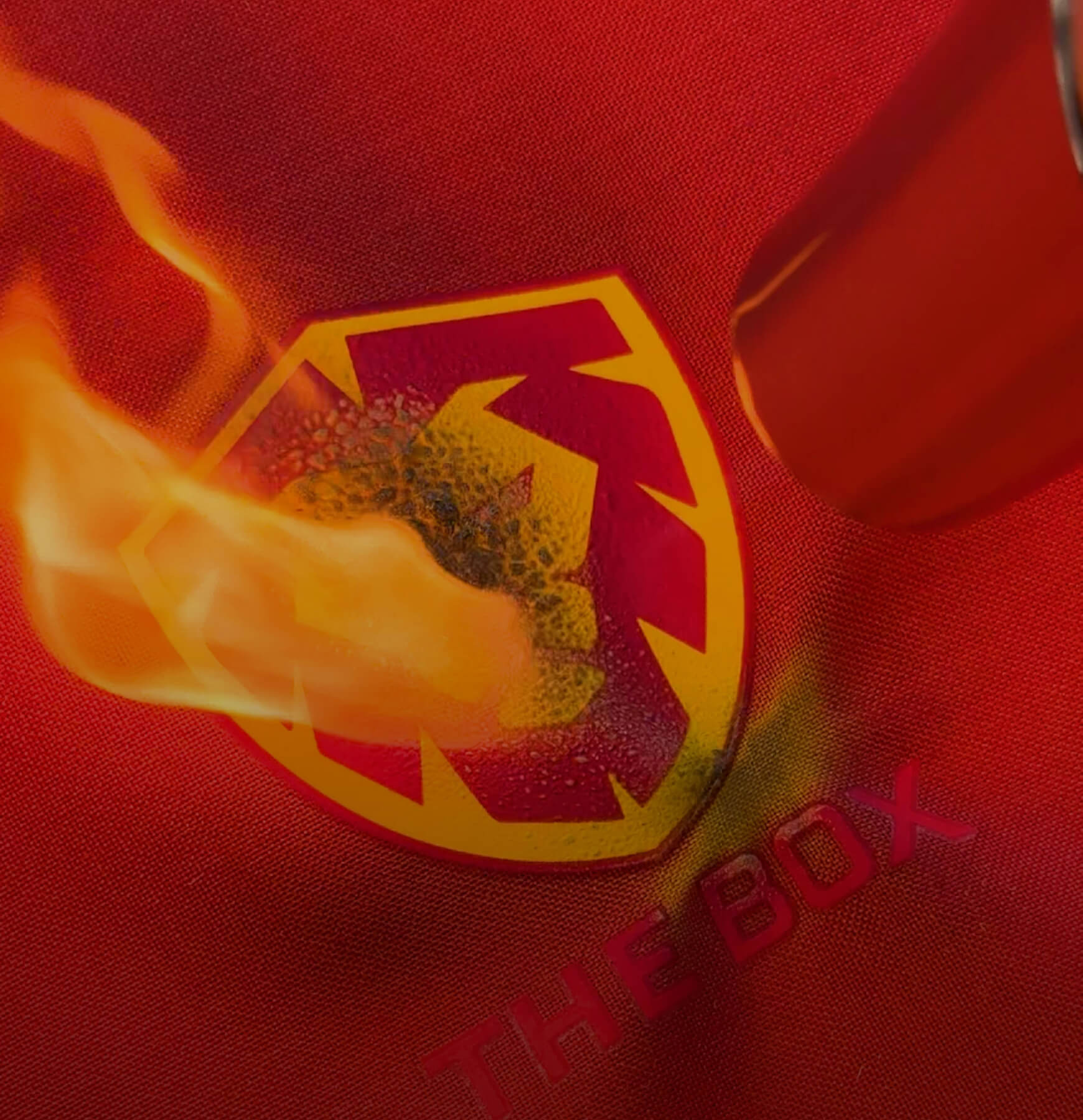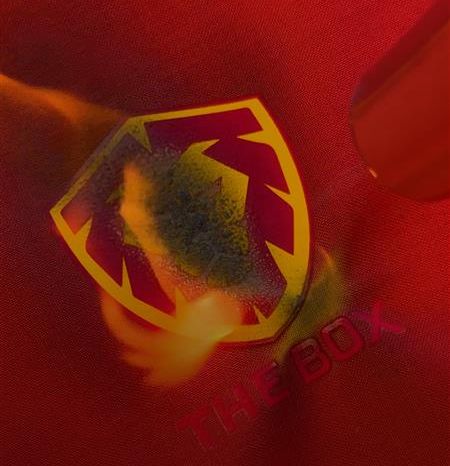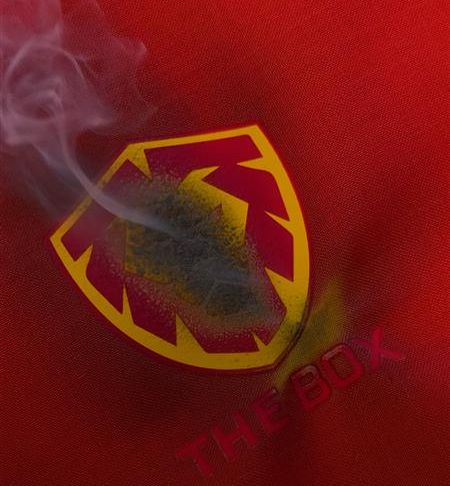Probably yes – if you’re working with workwear, motorsport, or protective apparel. Because once a textile is certified as flame-retardant, one simple rule applies: Your logo must meet the same safety standards.
In this article, you’ll learn
- what “flame-retardant” really means in practice,
- which standards you need to know,
- how these transfers are tested – including independent verification,
- and how to combine design and safety without compromise.
Flame-retardant logos: When safety becomes a design question

A logo is never just decoration. It stands for identity, quality, and responsibility.
But once it’s applied to a flame-retardant textile, the wrong material can quickly become a safety risk.
A logo that doesn’t meet the relevant standards can, in the worst case, cause the entire garment to lose its certification – or worse: keep burning.
What flame-retardant really means

In motorsport, the FIA 8856-2018 standard defines how materials must behave in the event of fire. A flame-retardant heat transfer meets these requirements.
Specifically:
- The flame self-extinguishes within a maximum of two seconds.
- The material does not continue to burn or drip.
- It remains stable enough to protect the layers beneath.
A small detail – with potentially life-saving impact.
Why exactly two seconds?
This time limit is not random. It’s based on tests simulating how quickly a material reacts after direct flame exposure. Two seconds are the critical threshold within which the fabric must extinguish the flame on its own to prevent ignition spread or skin burns.
Flame-retardant logo standards you need to know

The FIA 8856-2018 is only one of several standards that regulate textile performance in fire conditions. Depending on the field of use, different standards apply. They refer to the entire garment—but as soon as a logo is applied, it too must comply. In short: The logo must not reduce the protective performance of the garment.
Key standards include:
- FIA 8856-2018 – flame-retardant motorsport apparel
- EN ISO 11612 – protective clothing against heat and flames (industrial workwear)
- ISO 11611 – protective clothing for welding and allied processes
- NFPA 2112/2113 – US standards for flame-resistant industrial clothing
- EN 469 – firefighter protective gear
For all of these: once a logo is applied, it must be compatible with the same performance requirements.
That’s why we develop our transfers using the same test methods – such as ISO 15025 or ASTM D6413. These standards define how materials are tested (e.g., flame source, duration, distance), but not the performance thresholds that must be met.
Whether a material is certified as “flame-retardant” depends on the performance standards – such as FIA 8856-2018, which sets a maximum afterflame time of two seconds.
For industrial protective clothing, standards like EN ISO 11612 or NFPA 2112 apply. The logo must also comply with these requirements to avoid compromising the garment’s protective function.
How testing works
Our flame-retardant transfers follow the requirements of these standards – especially FIA 8856-2018 for motorsport and EN ISO 11612 for industrial protective clothing.
They specify that materials must self-extinguish within two seconds and not continue burning or glowing.
To ensure the logo meets these requirements, we test every material internally under realistic conditions: adhesion, temperature resistance, and flame behavior.
If required, flame-retardant performance can also be verified by independent testing institutes such as Hohenstein, SGS, or Intertek – for documented safety and full transparency across the supply chain.
This ensures your branding remains visible, compliant, and safe.
Balancing design freedom and safety

Anyone responsible for collections knows: safety standards are non-negotiable. At the same time, every garment must align visually with the brand – same color accuracy, same texture, same precision. The reality? Extra testing, certifications, and waiting times.
And sooner or later, the question arises:
“Is it even possible to have a flame-retardant logo that looks identical to the rest of the collection?”
Yes, it is – when technology and design go hand in hand.
The path to a flame-retardant transfer that works

At dekoGraphics, we develop heat transfers that are not only flame-retardant but also durable and chemical-resistant – for workwear that undergoes frequent industrial washing and heavy use.
Example:
This variant meets flame-retardant requirements while offering high resistance to chemicals and industrial laundering. It’s ideal for workwear and protective apparel where function and safety are top priorities.
Here’s how a compliant transfer is created:
- Each material is tested in-house for adhesion, washing, and heat resistance.
- The formulation is adapted to the specific textile.
- Results are documented and, if necessary, verified externally.
- Only then does serial production begin.
Solutions like ECOFLEX IND | DIGITAL FR offer a tested, compliant option – just make sure any solution you choose provides similar certifications and documentation.
Why this step matters
A verified test report is more than just a technical document. It’s a promise of trust – to customers, employees, and partners. When every element of a collection demonstrably meets the relevant standards, it proves that safety and brand quality go hand in hand.
A flame-retardant logo is therefore not a technical add-on. It’s part of a clear brand statement:
“We protect – down to the last detail.”
Frequently Asked Questions about Flame-Retardant Logos

1. What’s the difference between flame-retardant and fireproof? “Flame-retardant” means a material slows or stops the spread of fire – it self-extinguishes. “Fireproof” describes materials that can withstand extremely high temperatures without structural damage (e.g. fiberglass, ceramics). Heat transfers for clothing are flame-retardant, not fireproof.
2. Do logos have to pass the same tests as the garment itself? Not exactly the same, but they must be tested under the same conditions – for example, according to ISO 15025 or ASTM D6413. The logo must not negatively affect the garment’s protective performance.
3. Can a regular logo be used on flame-retardant clothing? Usually not. Standard transfers or prints may melt, drip, or keep burning – potentially invalidating the garment’s certification.
4. Which tests do independent institutes perform? Institutes like Hohenstein, SGS, or Intertek test flame spread, dripping behavior, and adhesion under heat. These optional tests help document and verify material compliance.
5. How often should flame-retardant logos be tested? Whenever materials, colours, or production methods change. Even small adjustments in ink or coating thickness can affect burn behavior. That’s why testing is recommended for each new production run or material change.
6. Are there sustainable flame-retardant transfers? Yes. Modern systems like ECOFLEX IND | DIGITAL FR combine flame-retardant performance with water-based inks and PVC-free chemistry – ideal for brands combining safety and sustainability.

Your next step toward safer details
Flame-retardant logos are essential wherever safety standards apply. Only those who consider every detail can protect both people and brand integrity. Use tested, compliant solutions – or check whether your current logos meet the same requirements.
➡️ Let’s test your logo together and confirm it performs as safely as it looks.
Safety isn’t a compromise – it’s part of your brand identity.
TRUSTED BY









